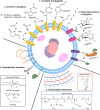Cell surface engineering and application in cell delivery to heart diseases
- PMID: 30524502
- PMCID: PMC6278044
- DOI: 10.1186/s13036-018-0123-6
Cell surface engineering and application in cell delivery to heart diseases
Abstract
Cell-based therapy has expanded its influence in cancer immunotherapy, regenerative medicine, and tissue engineering. Due to their secretory functions, differentiation capabilities, specific homing effects through chemotaxis, distinctive therapeutic potentials, and ex vivo expandability, cells have become an attractive reagent for advanced therapeutic strategies. Therefore, the ability to modify cells and manipulate their functions according to intended therapeutic designs has been the central scientific interest in the field of biomedical research. Many innovative methods have been developed with genetic modification of cells being the most advanced cell surface engineering technique. Although genetic modification is a powerful tool, it has a limited applicability due to the permanent modifications made on cells. Alternatively, many endeavors have been made to develop surface engineering techniques that can circumvent the limitations of genetic modification. In this review, current methods of non-genetic cell surface modification, including chemical conjugations, polymeric encapsulation, hydrophobic insertion, enzymatic and metabolic addition, will be introduced. Moreover, cell surface engineering plausible for cardiac remodeling and the future prospective will be discussed at the end.
Keywords: Cell surface engineering; cardiac diseases; cardiac repair; cell modification; cell therapy; mesenchymal stem cells.
Conflict of interest statement
Not applicable.Not applicable.The authors declare that they have no competing interests.Springer Nature remains neutral with regard to jurisdictional claims in published maps and institutional affiliations.
Figures


References
Publication types
Grants and funding
LinkOut - more resources
Full Text Sources

